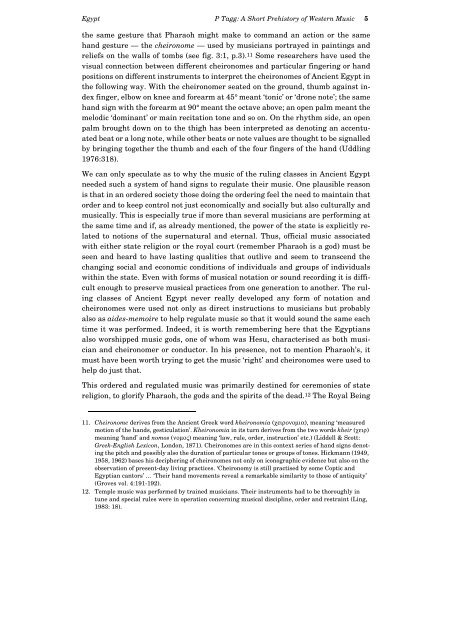A Short Prehistory of Western Music, Chapter 3
A Short Prehistory of Western Music, Chapter 3
A Short Prehistory of Western Music, Chapter 3
You also want an ePaper? Increase the reach of your titles
YUMPU automatically turns print PDFs into web optimized ePapers that Google loves.
Egypt P Tagg: A <strong>Short</strong> <strong>Prehistory</strong> <strong>of</strong> <strong>Western</strong> <strong>Music</strong> 5<br />
the same gesture that Pharaoh might make to command an action or the same<br />
hand gesture — the cheironome — used by musicians portrayed in paintings and<br />
reliefs on the walls <strong>of</strong> tombs (see fig. 3:1, p.3). 11 Some researchers have used the<br />
visual connection between different cheironomes and particular fingering or hand<br />
positions on different instruments to interpret the cheironomes <strong>of</strong> Ancient Egypt in<br />
the following way. With the cheironomer seated on the ground, thumb against index<br />
finger, elbow on knee and forearm at 45° meant ‘tonic’ or ‘drone note’; the same<br />
hand sign with the forearm at 90° meant the octave above; an open palm meant the<br />
melodic ‘dominant’ or main recitation tone and so on. On the rhythm side, an open<br />
palm brought down on to the thigh has been interpreted as denoting an accentuated<br />
beat or a long note, while other beats or note values are thought to be signalled<br />
by bringing together the thumb and each <strong>of</strong> the four fingers <strong>of</strong> the hand (Uddling<br />
1976:318).<br />
We can only speculate as to why the music <strong>of</strong> the ruling classes in Ancient Egypt<br />
needed such a system <strong>of</strong> hand signs to regulate their music. One plausible reason<br />
is that in an ordered society those doing the ordering feel the need to maintain that<br />
order and to keep control not just economically and socially but also culturally and<br />
musically. This is especially true if more than several musicians are performing at<br />
the same time and if, as already mentioned, the power <strong>of</strong> the state is explicitly related<br />
to notions <strong>of</strong> the supernatural and eternal. Thus, <strong>of</strong>ficial music associated<br />
with either state religion or the royal court (remember Pharaoh is a god) must be<br />
seen and heard to have lasting qualities that outlive and seem to transcend the<br />
changing social and economic conditions <strong>of</strong> individuals and groups <strong>of</strong> individuals<br />
within the state. Even with forms <strong>of</strong> musical notation or sound recording it is difficult<br />
enough to preserve musical practices from one generation to another. The ruling<br />
classes <strong>of</strong> Ancient Egypt never really developed any form <strong>of</strong> notation and<br />
cheironomes were used not only as direct instructions to musicians but probably<br />
also as aides-memoire to help regulate music so that it would sound the same each<br />
time it was performed. Indeed, it is worth remembering here that the Egyptians<br />
also worshipped music gods, one <strong>of</strong> whom was Hesu, characterised as both musician<br />
and cheironomer or conductor. In his presence, not to mention Pharaoh’s, it<br />
must have been worth trying to get the music ‘right’ and cheironomes were used to<br />
help do just that.<br />
This ordered and regulated music was primarily destined for ceremonies <strong>of</strong> state<br />
religion, to glorify Pharaoh, the gods and the spirits <strong>of</strong> the dead. 12 The Royal Being<br />
11. Cheironome derives from the Ancient Greek word kheironomia (χειρονομια), meaning ‘measured<br />
motion <strong>of</strong> the hands, gesticulation’. Kheironomia in its turn derives from the two words kheir (χειρ)<br />
meaning ‘hand’ and nomos (νομος) meaning ‘law, rule, order, instruction’ etc.) (Liddell & Scott:<br />
Greek-English Lexicon, London, 1871). Cheironomes are in this context series <strong>of</strong> hand signs denoting<br />
the pitch and possibly also the duration <strong>of</strong> particular tones or groups <strong>of</strong> tones. Hickmann (1949,<br />
1958, 1962) bases his deciphering <strong>of</strong> cheironomes not only on iconographic evidence but also on the<br />
observation <strong>of</strong> present-day living practices. ‘Cheironomy is still practised by some Coptic and<br />
Egyptian cantors’ … ‘Their hand movements reveal a remarkable similarity to those <strong>of</strong> antiquity’<br />
(Groves vol. 4:191-192).<br />
12. Temple music was performed by trained musicians. Their instruments had to be thoroughly in<br />
tune and special rules were in operation concerning musical discipline, order and restraint (Ling,<br />
1983: 18).














